Clearbit 2025: Testing the New Breeze Intelligence
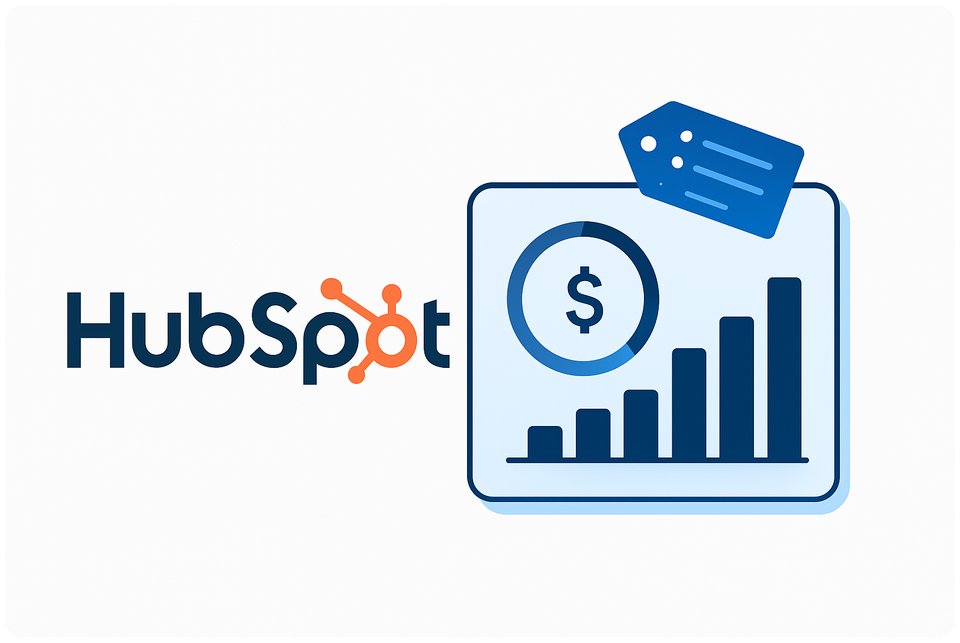
Remember Clearbit? HubSpot bought it in December 2024 and rebranded it as Breeze Intelligence.
I've been trying the new version since after the transition. The core data enrichment is still there, but everything else has changed. The pricing model, the interface, and how it integrates with your stack.
Some teams are liking the new version. Others are frustrated they lost the flexibility Clearbit used to offer.
This is what Clearbit was, what Breeze Intelligence is now, and whether the change matters for your team.
| Product Evaluation: Breeze by HubSpot | |
|---|---|
| Features | AI-powered enrichment, buyer intent signals, summaries, and meeting prep—all built into HubSpot workflows |
| Ease of Use | Integrated with Sequences and CoPilot UI, but some users report early bugs and unclear credit consumption |
| Value | Starts around $10 per 1,000 credits/month. No free tier, credits reset monthly. ROI depends on usage volume |
| Ideal For | HubSpot-native sales teams running high-volume outreach with a focus on data quality and automation |
| Not Ideal For | Light users, small teams, or anyone needing a free plan or budget enrichment tool |
| Overall Score | 7.2/10: Strong mid-market solution with enterprise potential, but steep ramp for casual users |
Clearbit Overview
Editor’s NoteThis article is based on my own testing of Breeze Intelligence, combined with a comprehensive analysis of verified user reviews from trusted platforms like G2. While I do work at Skrapp.io, this review reflects my genuine, unbiased opinion.
Clearbit was a B2B data platform that helped businesses find leads, enrich contact information, and maintain clean data. HubSpot acquired it in 2024. Now the technology powers Breeze Intelligence inside HubSpot's CRM.
What Clearbit Did vs What Breeze Intelligence Does
What Clearbit did (in one sentence)
Clearbit collected B2B data from over 250 sources and delivered it to your CRM. Clean, standardized contact and company information.
What Breeze Intelligence does now
HubSpot's Breeze Intelligence does the same core job but operates within HubSpot's ecosystem. Same data sources, same enrichment process, but integrated into HubSpot's CRM and marketing tools.
Who it's for
Both Clearbit and Breeze Intelligence work best for:
- Teams with mature sales stacks that already have CRM and sales engagement tools
- Organizations that focus on data enrichment and visitor identification
- Companies with developers or RevOps specialists who manage Salesforce or complex CRM workflows
- Marketing teams that pursue account-based marketing strategies
The technology serves B2B companies that want to learn about their website visitors and leads to accelerate their growth.
Key difference: Engagement capabilities changed with HubSpot
Original Clearbit had powerful data capabilities but lacked built-in engagement features. You couldn't send emails, automate outreach, make calls, or directly engage with leads. You needed additional tools in your stack to act on the data Clearbit provided.
Breeze Intelligence operates differently. Since it's part of HubSpot's ecosystem, you can use AI to generate sales outreach and marketing emails, and it integrates with HubSpot's CRM data to craft personalized outreach. HubSpot also offers Breeze Prospecting Agent to automate sales outreach.
The trade-off: Clearbit was good at showing you who to target with rich context, but you needed companion tools to execute. Breeze Intelligence gives you both the intelligence and the engagement tools, but you're locked into HubSpot's platform to get the full benefit.
Clearbit Core Features: What Changed and What Stayed
CRM Enrichment: Auto-updates for Salesforce, HubSpot
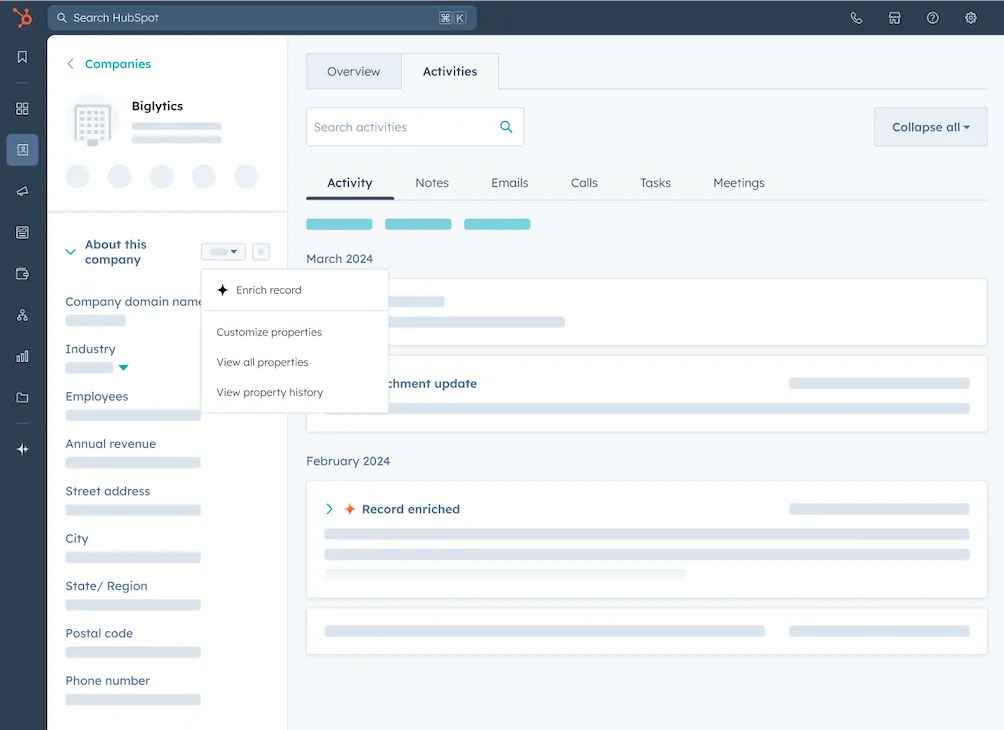
Clearbit's integration with major CRMs updated your lead, contact, and account records with over 100 B2B attributes from 250+ data sources. Your sales team got instant access to company size, industry, funding, and the technologies companies used instead of researching basic information. It also refreshed this data as changes occurred.
Breeze Intelligence maintains this core functionality but operates within HubSpot's ecosystem. The same data enrichment happens, but now it's built into HubSpot's interface and pricing structure rather than being a separate tool.
Reveal: Identify anonymous website visitors

Clearbit's standout feature turned anonymous website traffic into actionable lead information. The system matched IP addresses to company profiles, giving firmographic data about businesses visiting your site even without form completion. Zendesk reported that Clearbit Reveal identified 11x more anonymous traffic than competing services.
This visitor identification capability continues in Breeze Intelligence, but it's now packaged as part of HubSpot's broader marketing suite rather than a standalone feature.
Prospecting Agent: Filter by job title, industry, and more
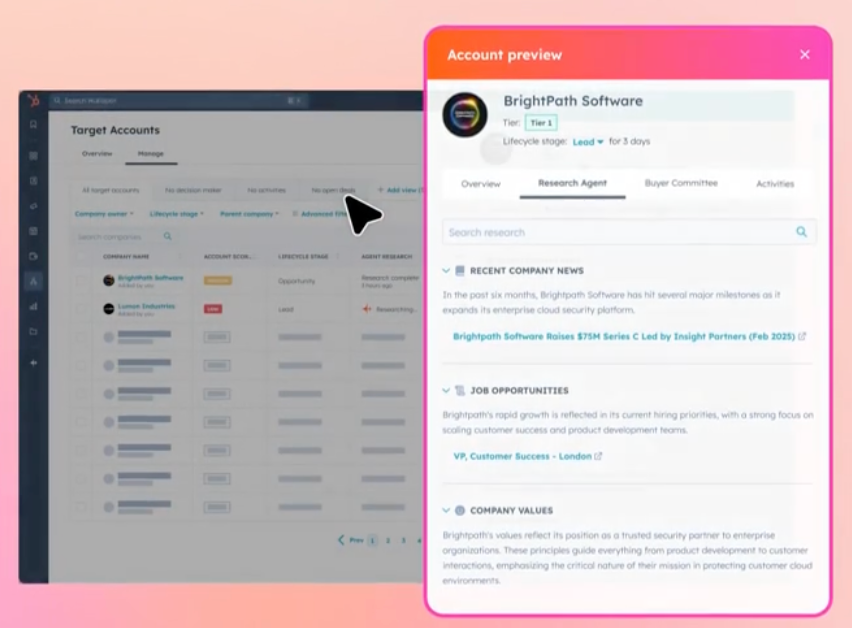
The prospecting database let you search companies and contacts using specific filters including job title, industry, location, and company size. This searchable database helped you find decision-makers matching your ideal customer profile. The process required manual work: you had to search, filter, save leads, then export them to another system.
Breeze Intelligence changes this. Instead of manual prospecting, HubSpot now offers Breeze Prospecting Agent: an AI-powered tool that automates prospect research, crafts personalized outreach, and handles scheduling and sending communications. The agent analyzes thousands of data points across target accounts and generates tailored outreach strategies automatically.
Contact & Company Lookup: Firmographic insights
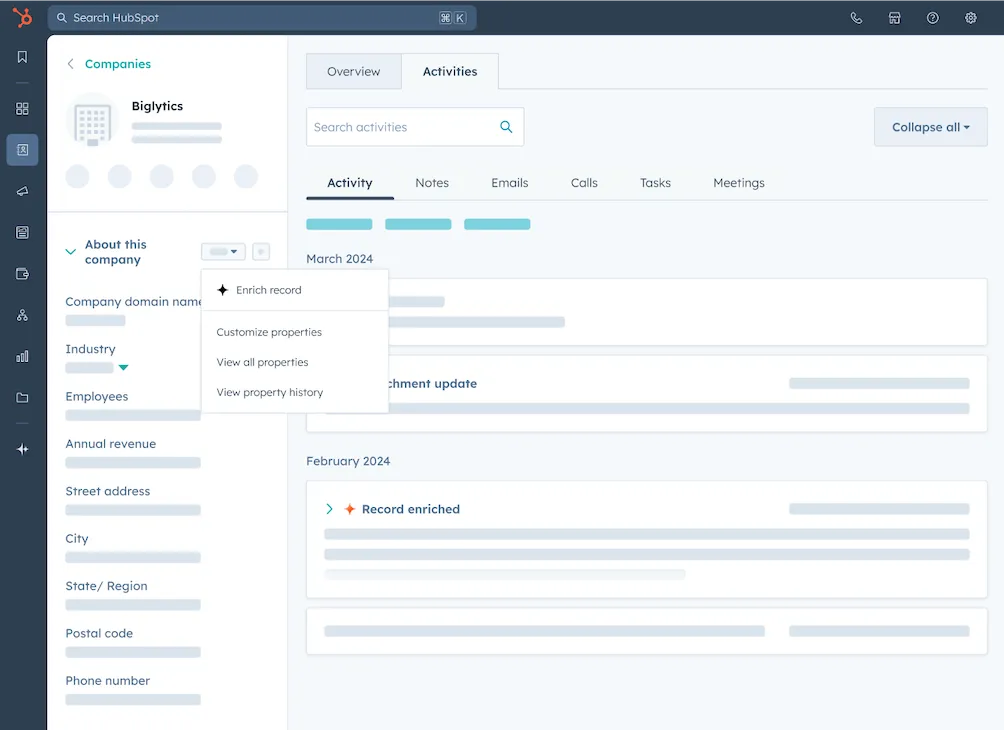
Clearbit offered detailed company and contact lookups. You could enter a domain name to get back company-level data like industry, location, employee count, revenue range, tech stack, and even founder details. For individuals, an email address would return names, job titles, social handles, seniority, and other key identifiers. These insights helped personalize outreach, enrich CRM records, and segment audiences more precisely.
Now, under HubSpot’s Breeze Intelligence, the same lookup functionality is built directly into your CRM workflows. You can enrich contacts and companies automatically using HubSpot's credit-based model. The data returned is similar (firmographics, social profiles, and role-based context) but the experience is more embedded.
Limitation: Manual export/import process
Under Clearbit, enrichment often required manual export and import steps. You’d select records, choose data attributes, export a CSV, and re-upload that into your engagement or sales tools. Export capacity was also limited: only 2,500 enriched records could be pulled from segments, with priority given to high-traffic accounts.
Breeze Intelligence improves the flow slightly, but not completely. While enrichment happens inside HubSpot, exporting enriched lists for use outside the platform still involves manual steps. You're limited to 300 exports per day, with a cap on simultaneous jobs, and large exports are auto-compressed. There’s still no true auto-sync to third-party tools beyond what HubSpot integrations already support. So if you’re planning to move data into tools like Outreach or Salesloft, you’ll still need to handle CSV exports and manual uploads.
Clearbit (Now Breeze) Interface: Is It Easy To Use?
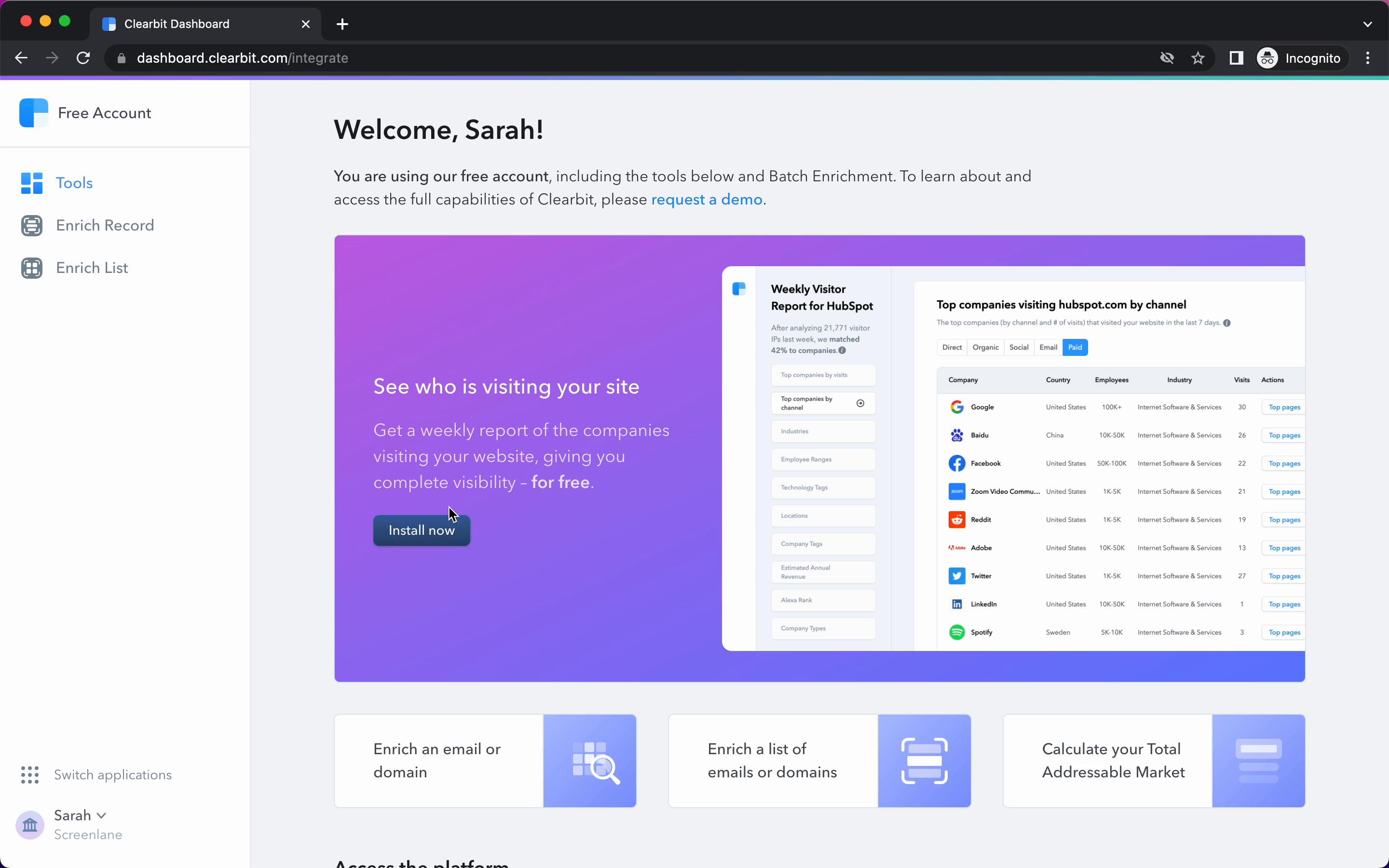
Setup experience: API-first or dashboard?
Clearbit was never designed to be a dashboard-first product. It leaned heavily on its API, and most users interacted with it through integrations, not its interface. To get started, you had to fetch your API key from the settings panel and configure connections in tools like Salesforce or HubSpot manually. The dashboard existed, but it functioned more like a backend control panel than an actual workspace.
Since being rebranded by HubSpot as Breeze Intelligence, the product feels less like an API wrapper and more like a native CRM feature. Enrichment happens automatically in HubSpot lists and contact records. There's no need to manually install anything or plug in API keys. The shift reduces setup friction, but only if you're already living in HubSpot.
For users outside the HubSpot ecosystem, this is a limitation. There are tools built specifically for non-technical teams that offer similar enrichment and lookup functionality without requiring CRM-level setup. Skrapp is one of those.
Is onboarding smooth for non-technical users?
Clearbit's onboarding can be tough for non-technical users. The platform expects you to have some technical knowledge, especially during Salesforce or HubSpot integration setup. The process needs you to understand API implementation, which can overwhelm marketing teams without developer support. The documentation gives you a full picture, but the platform doesn't have the simple setup wizards you'd find in other SaaS tools. That said, the data enrichment runs smoothly in the background once everything's set up.
Chrome Extension: Valuable or Redundant?
Before the transition to Breeze, Clearbit offered a Chrome extension (Clearbit Connect) that worked directly inside Gmail. It allowed you to look up contacts by domain, verify email addresses, and view social profiles from your inbox. For many teams, this was the easiest entry point into Clearbit’s data ecosystem.
That extension still exists, but its role has shrunk. HubSpot’s Breeze experience prioritizes CRM-native workflows, not browser-based ones. If you're looking for quick enrichment while browsing LinkedIn or Gmail, you’ll find the current Breeze model doesn't cover that use case natively anymore.
For teams that prospect fast, lightweight tools that still support Chrome-based lookup have become more attractive. Some options also offer tighter filtering, more control over exports, and less reliance on long-term CRM strategy.
Clearbit (Now Breeze) Security Measures
The platform is GDPR-compliant and SOC 2 certified, giving regulated teams peace of mind. HubSpot’s infrastructure automatically anonymizes IP addresses for analytics tracking and blocks personal data from being shared with third-party tools like Google Analytics. This baked-in compliance helps businesses meet privacy standards like GDPR and CCPA without needing to configure every setting manually.
What used to be managed through Clearbit’s standalone Privacy Request Center is now embedded into HubSpot’s broader data governance tools. Users can access, correct, or delete their personal data directly through self-service workflows. Encryption is applied to all data in transit and at rest, and HubSpot adds regular security reviews and platform-wide controls.
The Community Data Opt-Out feature still exists, it now lives within HubSpot's privacy settings. It gives teams control over whether their enriched contacts are visible to other users of the network. This level of transparency is a plus for teams dealing with sensitive or proprietary prospect data.
That said, if you're looking for a simpler experience, one that’s privacy-compliant but doesn't require navigating enterprise-grade infrastructure, there are leaner alternatives.
Clearbit (Now Breeze) Integrations
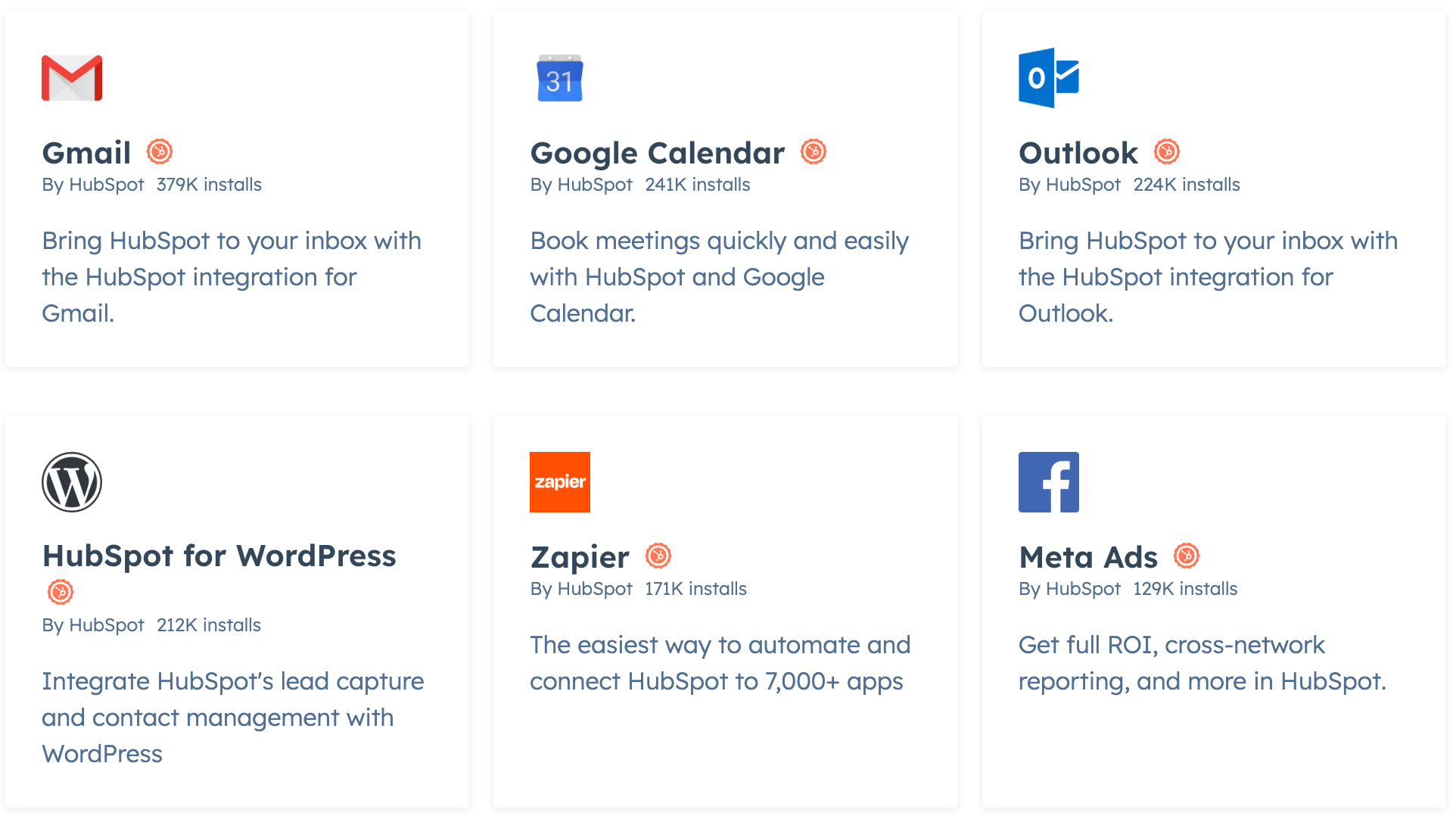
Breeze continues to offer deep, native integrations with the core tools that Clearbit supported: Salesforce, HubSpot, Segment, Google Ads, and more.
In Salesforce, it enriches leads, contacts, and accounts with real-time firmographic and technographic data. The enrichment happens automatically as new records are created, so sales teams don’t waste hours researching. Segment users can trigger enrichment via Identify events and route enriched data to over 180 connected tools instantly.
Within HubSpot, the experience is tighter. Breeze allows you to shorten forms dynamically (based on known data), score leads instantly, trigger routing to reps, and get alerts when key accounts revisit your website. These are woven into HubSpot’s native interface, meaning you never have to switch tabs.
Breeze Outreach Capabilities: What’s Changed Since Clearbit
In its original form, Clearbit stopped at enrichment. You could identify companies, enrich contacts, and segment leads, but when it came to actually sending outreach or tracking engagement, you had to export everything to a separate platform.
With the shift to Breeze Intelligence inside HubSpot, that’s no longer the case. Breeze now includes native outreach functionality through tools like Prospecting Agent and Breeze Copilot. These features allow you to trigger automated emails, schedule follow-ups, and assign tasks based on enriched data, all within HubSpot. There’s no need to export leads just to engage them. You can run enrichment, scoring, segmentation, and outbound all in the same interface.
That said, this workflow assumes you're fully invested in HubSpot. For teams outside the ecosystem, the core experience is still segmented: you’ll need to pull enriched data out manually and plug it into other sales engagement tools.
Breeze (formerly Clearbit) Customer Support
Your experience with a tool can depend on their customer support. Previously, Clearbit users (depending on plan) could get help via email, support forms, and a strong documentation base. Enterprise clients enjoyed dedicated Customer Success Managers (CSMs). Real-time chat was not universally available, which meant smaller teams often waited on email responses.
Now integrated into HubSpot’s Breeze suite, support has become more layered. Paid HubSpot plans typically include:
- Email support and Help Center articles
- In-app guided help and Chatbots (depending on plan)
- Dedicated onboarding and CSMs for Pro/Enterprise users
- Access to HubSpot Community
The addition of in-app contextual guidance and chat improves the baseline experience. But unless you're on a high-tier HubSpot plan, you might still rely heavily on documentation and email.
Rating: 7/10
Email support remains solid and timely, documentation is extensive, and enterprise clients have high-touch support. But for mid-market teams, the lack of immediate chat can feel like an oversight—especially given the credit-based pricing model they're working within.
Breeze (formerly Clearbit) Pricing Model: Is It Worth the Cost?
Before, Clearbit pricing ran high: quotes often started around $18,000/year for Reveal and climbed based on volume and features.
Since rebranding as Breeze, the pricing has shifted significantly. Breeze now runs natively inside HubSpot and operates on a credit-based model—one that requires a paid HubSpot subscription. You purchase HubSpot Credits, which fuel various Breeze-powered actions like enrichment, form optimization, and intent tracking.
- Breeze Pricing: HubSpot Credit-Based Model
You buy HubSpot Credits, which reset monthly and do not roll over. These credits are shared across HubSpot’s usage-based tools, including Breeze.
Official pricing via HubSpot:
| Credit Pack | Monthly Cost |
|---|---|
| 1,000 credits | $10/month |
| 10,000 credits | $100/month |
| 100,000 credits | $1,000/month |
Breeze actions consume credits at these estimated rates:
| Feature | Credit Cost |
|---|---|
| One enriched company (Reveal) | 10 credits |
| One enriched contact | 10 credits |
| One enriched smart property | 10 credits |
| One customer conversation via agent | 100 credits |
Source: HubSpot Product & Services Catalog, July 2025
If you exceed your monthly credits, you’ll be auto-upgraded to the next credit tier and billed a prorated amount for the current cycle. Capacity packs remain active until your contract renewal, even if usage drops.
No Free Tier Post-Rebrand
As of 2025, all free Clearbit access, including legacy Reveal Lite and TAM tools, was officially sunset. Breeze now requires:
- A paid HubSpot subscription (Sales Hub Pro+ for Reveal features)
- Separate HubSpot Credits, billed monthly
- No free trials for enrichment or intent data
Pricing Comparison: Breeze vs. Skrapp.io
| Feature | Breeze (HubSpot) | Skrapp.io |
|---|---|---|
| Starting price | ~$10/month for 1,000 credits + HubSpot subscription | £0/month for 50 emails; £37/mo for 1k credits |
| Free tier | No (eliminated April 2025) | Yes (50–150 emails/month) |
| Credit scaling | Fixed bundles; no rollover | Monthly credits roll over |
| CRM integrations | Deep native integrations with HubSpot, Salesforce (API) | HubSpot, Pipedrive, CSV export |
| Outreach tools | Integrated email sequences via HubSpot Sales Hub | Export-only; supports external tools |
| Ideal user | Mid-size to enterprise HubSpot users | Freelancers, startups, lean sales teams |
Who Should Pay for Breeze?
Breeze makes sense if you:
- Operate at scale inside HubSpot or Salesforce
- Use automated enrichment, form prefill, and intent detection
- Can consume hundreds to thousands of credits per month
- Want native AI agents and enrichment tools inside your CRM
You may skip Breeze if you:
- Are a solo founder or SDR running lean outreach
- Just need email lists and contact scraping
- Are on a tight budget
- Want free credits or rollover
In those cases, Skrapp.io (or similar tools like Apollo or Hunter) may offer a more affordable, flexible option.
What Do Users Say About Clearbit?
My analysis of real-life user reviews and public feedback shows mixed reactions to Breeze since its rebrand from Clearbit. While some users are excited by the AI tools and HubSpot integration, others report surprise costs and some confusion:
| Sentiment | User Quote | Source |
|---|---|---|
| Neutral | “Clearbit has been converted into Breeze Intelligence and connected into the HubSpot product.” | Reddit (TheJonMartin) |
| Neutral | “With Clearbit now under the HubSpot umbrella, data accuracy might improve.” | Reddit (vinayakjjw) |
| Negative | “Unknown to me, automatic enrichment was turned on in HubSpot... Might have just cost my company $11k.” | |
| Negative | “Unless it’s custom to your use case... Breeze is like all the other prepackaged AIs and entirely useless.” | Reddit (Sowhataboutthisthing) |
| Positive | “The new Breeze feature! I love the innovative ways HubSpot finds to make our lives easier.” | G2 Review |
| Positive | “Prospecting and customer agent have a lot of potential.” | Reddit (paul_schmidt) |
Pros: Pros: Fast insights, strong HubSpot integration
Users like how Breeze works inside HubSpot’s CRM and reduces time spent on manual prep. Reps highlight the ability to summarize contact data instantly, prep for meetings, and auto-enrich forms with minimal clicks. AI features like Copilot and dynamic sequences are mentioned frequently by HubSpot Sales Hub reviewers.
Cons: Automatic charges, unclear default
The biggest problem users mention is Clearbit's pricing structure. Small businesses and startups struggle to justify the cost. Users also point out data issues, with some finding outdated information.
Users feel frustrated by Clearbit's manual export/import workflows that need extra steps compared to all-in-one platforms. Some mention trouble reaching the sales team for demos and questions, that indicates gaps in service.
Platform Ratings & Sentiment Summary
Since Breeze is integrated into HubSpot, it doesn’t yet have its own standalone G2 or TrustRadius page. However, reviews of HubSpot’s Sales Hub and Clearbit provide context:
HubSpot Sales Hub (with Breeze):
★ 4.4/5 on G2 (12,399 reviews)
Clearbit Old Ratings:
★ 4.4/5 on G2 (626 reviews)
★ 8.6/10 on TrustRadius (73 reviews)
★ 5/5 on Gartner Peer Insights (2 reviews)
Is Clearbit Worth It?
I spent weeks testing Breeze (formerly Clearbit) after its HubSpot rebrand. So, is this new credit-based enrichment system actually worth the cost?
Best for: Growth teams inside HubSpot
Breeze makes the most sense for:
- Revenue teams that already operate inside HubSpot or Salesforce
- Mid-size to enterprise orgs processing large lead volumes
- Reps who want buyer intent, AI summaries, and enriched forms without switching tools
- Teams that regularly use CoPilot, Sequences, and CRM views to drive outbound motion
One user said Breeze “summarized everything I needed about a contact before a meeting—saved me 30 minutes of prep.” Another added, “It finally feels like AI is doing something useful for my day-to-day.”
Not for: Budget-conscious or outbound-only teams
Breeze may not be ideal for:
- Founders or SDRs sending cold emails manually
- Teams on tight budgets needing email verification only
- Users outside of HubSpot’s ecosystem
- Anyone expecting rollover credits or a free tier
As one reviewer put it: “It’s great tech, but you hit the credit wall fast and have to top up monthly.” Another flagged that “there’s no way to test this unless you’re already paying for HubSpot—and even then, it’s hard to model ROI without a large database.”
While Breeze delivers speed and intelligence, its value increases the more you automate and integrate your workflows. If you're early-stage or only need lead emails, cheaper alternatives like Skrapp.io may serve you better.
Looking for a Clearbit Alternative?
After Clearbit’s rebrand to Breeze, the product is now tightly embedded within HubSpot, and no longer offers standalone access or a free tier. That shift leaves many SMBs looking for flexible, lightweight alternatives.
Skrapp, Apollo, Hunter: Easier Options for SMBs
If your team doesn’t need full HubSpot integration, tools like Skrapp.io may offer better flexibility. Skrapp’s free plan includes 150 verified emails/month, and its Professional plan starts at ~$37 for 1,000 credits—with credits that roll over and no HubSpot lock-in.
Apollo.io is a sales intelligence suite with 275M+ contacts and basic automation. At $49/user/month, it’s popular among teams that want CRM + enrichment in one place. Even its free plan includes generous email and mobile credits.
Hunter specializes in verified email lookup and domain-level research. It’s simple, reliable, and starts at $49/month, with 50 monthly searches on the free plan.
Unlike Breeze, these platforms don’t require a HubSpot subscription, and most offer entry-level access without a sales call—making them ideal for budget-conscious or fast-moving teams.
FAQs on Clearbit
What is the use of Clearbit?
Clearbit helps B2B teams enrich lead and account data in real time. You give it an email or domain, and it returns firmographic details like company size, revenue, tech stack, and more. It’s mostly used for lead scoring, segmentation, personalization, and account-based marketing.
Is Clearbit GDPR compliant?
Clearbit follows the European Union's General Data Protection Regulation (GDPR) and the California Consumer Privacy Act (CCPA). The platform has EU suppression settings that block data returns for people with EU or unknown locations during person enrichment. You can submit data requests through their Privacy Request Form to access, correct, or delete your personal information. The platform lets you block EU-based contacts from appearing in search results when you use it for prospecting.
Can I use Clearbit without a developer?
You can use Clearbit without technical help, but you'll get better results with developer support. Web forms and landing page setup usually need technical expertise. Some browsers and older form builders might not work well with the platform. The Chrome extension works fine for non-technical users. The platform's API-based approach works best when someone on your team understands technical implementation.
How accurate is Clearbit's data?
Clearbit maintains high accuracy, 95% for company data and 90% for person data. Each record goes through four verification steps: a 30-day recency check, data source verification, anomaly testing, and human review by their research team. This process results in 94% email deliverability. Records get rebuilt every 30 days to stay current. This frequent update helps track roughly 30,000 new company registrations, 60,000 company relocations, and 122,400 executive job changes during that period.
What is Clearbit Reveal?
Clearbit Reveal matches IP addresses to company profiles to identify anonymous website visitors. The tool uses its own IP address dataset with 50+ company enrichment attributes instead of relying heavily on third-party cookies. Marketers can see which companies visit their website without filling out forms. They can create tailored site experiences for key accounts and run dynamic ads based on behavior and company information.
Does Clearbit work with Facebook Ads?
Clearbit connects with Facebook Ads Manager. This integration helps you target specific companies through Facebook's advertising platform. You can build custom audiences using Clearbit's firmographic data to run account-based marketing campaigns on Facebook.
How much does Clearbit cost?
Clearbit pricing starts at $20,000/year for most enrichment and Reveal packages. Smaller teams using only basic enrichment via the HubSpot integration can access limited features starting around $99/month through the HubSpot App Marketplace.
Custom API-based plans scale up fast depending on usage volume, number of records, and features like Ads or Reveal. There’s also a free tier with very limited data enrichment—more like a sandbox than a usable plan.
What is the alternative to Clearbit?
Some alternatives include:
- Skrapp.io – Enterprise-grade B2B data platform
- Apollo – Lead enrichment + email outreach, with a generous free plan
- LeadMagic – Focused on IP-based visitor identification like Clearbit Reveal
- Hunter.io – Lightweight option for email/domain lookup
Is Clearbit owned by HubSpot?
No. Clearbit is an independent company. It integrates with HubSpot and other CRMs, but it’s not owned or operated by HubSpot.
Is Clearbit suitable for small businesses and startups?
Not really, Clearbit's pricing and features are better suited for enterprises with large marketing budgets. Small businesses and startups may find alternatives like Skrapp or Hunter more cost-effective and practical for their needs.
Is Clearbit suitable for small businesses and startups?
Not really, Clearbit's pricing and features are better suited for enterprises with large marketing budgets. Small businesses and startups may find alternatives like Skrapp or Hunter more cost-effective and practical for their needs.
Does Clearbit offer any free services or trials?
No. As of 2025, Clearbit has phased out most of its free services. They used to offer limited free credits, but currently, free Clearbit accounts are not being created. The platform now focuses on paid subscriptions starting at $12,000-$24,000 annually.
